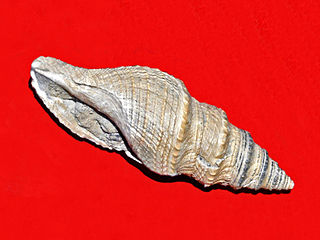 W
WAcamptogenotia is an extinct genus of predatory sea snails, marine gastropod mollusks belonging to an unassigned family in the Conoidea.
 W
WAdapisoriculidae is an extinct family of eutherian mammals present during the Paleocene and possibly Cretaceous. They were once thought to be members of the order Erinaceomorpha, closely related to the hedgehog family (Erinaceidae), because of their similar dentition, or to be basal Euarchontans. They were also thought to be marsupials at one point. Most recent studies show them to be non-placental eutherians, however.
 W
WAnaptomorphinae is a pre-historic group of primates known from Eocene fossils in North America and Europe and later periods of Paleocene Asia, and are a sub-family of omomyids. The anaptomorphines is a paraphyletic group consisting of the two tribes Trogolemurini and Anaptomorphini. Anaptomorphine radiation in Wyoming, one of the most detailed records of changes within populations and between species in the fossil record, has provided remarkable evidence of transitional fossils.
 W
WArchaeohyracidae is an extinct family comprising four genera of notoungulate mammals known from the Paleocene through the Oligocene of South America.
 W
WArctocyonians are a clade of laurasiatherian mammals whose stratigraphic range from the Palaeocene to the Early Eocene epochs. They were among the earliest examples of major mammalian predators after the Cretaceous–Paleogene extinction event. While some classify arctocyonians as stem-artiodactyls, others have classified the group as members of Ferae. There are three families classified in the order: Arctocyonidae, Oxyclaenidae, and Quettacyonidae.
 W
WAstrapotheria is an extinct order of South American and Antarctic hoofed mammals that existed from the Late Paleocene to the Middle Miocene, 59 to 11.8 million years ago. Astrapotheres were large and rhinoceros-like animals and have been called one of the most bizarre orders of mammals with an enigmatic evolutionary history.
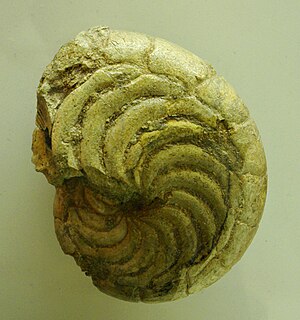 W
WAturia is an extinct genus of Paleocene to Miocene nautilids within Aturiidae, a monotypic family, established by Campman in 1857 for Aturia Bronn, 1838, and is included in the superfamily Nautilaceae in Kümmel 1964.
 W
WBemalambdidae is an extinct family of pantodont mammals known from Early and Middle Paleocene of China.
 W
WCarpolestidae is a family of primate-like Plesiadapiformes that were prevalent in North America and Asia from the mid Paleocene through the early Eocene. Typically, they are characterized by two large upper posterior premolars and one large lower posterior premolar. They weighed about 20-150g, and were about the size of a mouse. Though they come from the order, Plesiadapiformes, that may have given rise to the primate order, carpolestids are too specialized and derived to be ancestors of primates.
 W
WClavilithes is an extinct genus of fossil sea snails, marine gastropod mollusks in the family Fasciolariidae, the tulip snails and spindle snails.
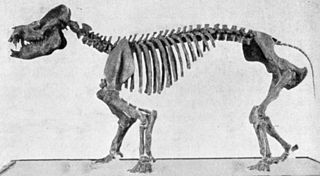 W
WCoryphodon is an extinct genus of mammal.
 W
WCoryphodontidae is an extinct family of pantodont mammals known from the Late Paleocene to the Middle Eocene of Eurasia and North America.
 W
WCreodonta is an extinct, possibly polyphyletic order of carnivorous mammals that lived from the Paleocene to the Miocene epochs. Because they both possess carnassial teeth, creodonts and carnivorans were once thought to have shared a common ancestor, but given that different teeth are involved in making up the carnassials, this appears to be a case of evolutionary convergence. Carnassials are also known in other mammal clades, such as in the extinct bat Necromantis.
 W
WCrommium is an extinct genus of sea snails, marine gastropod mollusks in the family Naticidae, the moon snails.
 W
WDidolodontidae is a family of "condylarth" mammals known from the Paleocene to the late Eocene of South America.
 W
WDinocerata is an extinct order of plant-eating, rhinoceros-like hoofed mammals famous for their paired horns and tusk-like canine teeth. The earliest dinoceratan, Prodinoceras, appeared in Asia during the Paleocene, but nearly all later types are from North America. Dinoceratans lived alongside another group of large Eocene plant-eaters, the brontotheres. The most famous dinoceratan is Uintatherium.
 W
WDinopanorpidae is a small family of extinct insects in the order Mecoptera (scorpionflies) that contains two genera and seven species.
 W
WDiplocynodon is an extinct genus of alligatoroid that lived during the Paleocene to middle Miocene in Europe. It looked very similar to the modern caiman in that it was small and had bony armour scutes covering its neck, back, belly, and tail. The longest Diplocynodon recovered was 4 feet in length and probably fed on small fish, frogs, and took insects when young.
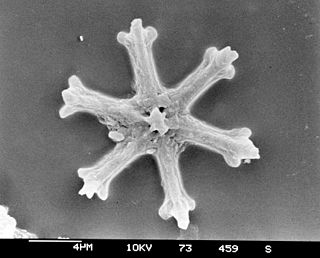 W
WDiscoaster is a genus of extinct star-shaped marine algae, with calcareous exoskeletons of between 5-40 μm across that are abundant as nanofossils in tropical deep-ocean deposits of Neogene age. Discoaster belongs to the haptophytes. About 100 species can be recognized.
 W
WEuzaphlegidae is a family of extinct escolar-like fish closely related to the snake mackerels. Fossils of euzaphlegids are found from Paleocene to Late Miocene-aged marine strata of Europe, the Caucasus Mountains, India, Iran, Turkmenistan, Italy, and Southern California.
 W
WGastornis is an extinct genus of large flightless birds that lived during the late Paleocene and Eocene epochs of the Cenozoic era. The genus is currently thought to contain three or four distinct species, known from incomplete fossil remains, found in western-central Europe. More complete specimens are known from a fourth, North American species, which had previously been classified in the distinct genus Diatryma. Many scientists now consider Diatryma to be so similar to the other species of Gastornis that it should also be included in that genus. A fifth species, also previously classified in its own genus, is known from China.
 W
WHapalodectidae is an extinct family of relatively small-bodied mesonychian placental mammals from the Paleocene and Eocene of North America and Asia. Hapalodectids differ from the larger and better-known mesonychids by having teeth specialized for cutting, while the teeth of other mesonychids, such as Mesonyx or Sinonyx, are more specialized for crushing bones. Hapalodectids were once considered a subfamily of the Mesonychidae, but the discovery of a skull of Hapalodectes hetangensis showed additional differences justifying placement in a distinct family. In particular, H. hetangensis has a postorbital bar closing the back of the orbit, a feature lacking in mesonychids. The skeleton of hapalodectids is poorly known, and of the postcranial elements, only the humerus has been described. The morphology of this bone indicates less specialization for terrestrial locomotion than in mesonychids.
 W
WHyaenodontidae is a family of extinct predatory mammals, and is the type family of the extinct mammalian order Hyaenodonta. Hyaenodontids were important mammalian predators that arose during the late Paleocene and persisted well into the Miocene. They were considerably more widespread and successful than the oxyaenids, the other clade historically considered part of Creodonta.
 W
WIsotemnidae is an extinct family of notoungulate mammals known from the Paleocene to Middle Miocene of South America.
 W
WLazarussuchus is a genus of basal choristodere, a type of amphibious reptile, known from France, Germany, and the Czech Republic. Fossils have been found in Late Paleocene, Late Oligocene, and Early Miocene deposits, meaning that the genus lasted about 40 million years. Two species have been named: the type species L. inexpectatus ("unexpected") from the late Oligocene of France and Germany and L. dvoraki from the early Miocene of the Czech Republic. It was not a large animal; the skull of L. inexpectatus was only about 4.53 centimeters long (1.78 in). A complete specimen of Lazarussuchus with preserved soft tissue was found from the Late Paleocene of France, but has not been assigned to a species.
 W
WLitopterna is an extinct order of fossil hoofed mammals from the Cenozoic era. The order is one of the five great clades of South American ungulates that gave the continent a unique fauna until the Great American Biotic Interchange. Like other endemic South American mammals, their relationship to other mammal groups has long been unclear.
 W
WMacraucheniidae is a family in the extinct South American ungulate order Litopterna, that resembled various camelids. The reduced nasal bones of their skulls was originally suggested to have housed a small proboscis, similar to that of the saiga antelope. However, one study suggests that they were openings for large moose-like nostrils. Their hooves were similar to those of rhinoceroses today, with a simple ankle joint and three digits on each foot. Thus, they may have been capable of rapid directional change when running away from predators, such as large phorusrhacid terror birds, sparassodont metatherians, giant short-faced bears (Arctotherium) and saber-toothed cats (Smilodon). Macraucheniids probably lived in large herds to gain protection against these predators, as well as to facilitate finding mates for reproduction.
 W
WMesonychia is an extinct taxon of small to large-sized carnivorous ungulates related to the cetartiodactyls. Mesonychids first appeared in the early Paleocene, went into a sharp decline at the end of the Eocene, and died out entirely when the last genus, Mongolestes, became extinct in the early Oligocene. In Asia, the record of their history suggests they grew gradually larger and more predatory over time, then shifted to scavenging and bone-crushing lifestyles before the group became extinct.
 W
WMesonychidae is an extinct family of small to large-sized omnivorous-carnivorous mammals. They were endemic to North America and Eurasia during the Early Paleocene to the Early Oligocene, and were the earliest group of large carnivorous mammals in Asia. They are not closely related to any living mammals. Mesonychid taxonomy has long been disputed and they have captured popular imagination as "wolves on hooves," animals that combine features of both ungulates and carnivores. Skulls and teeth have similar features to early whales, and the family was long thought to be the ancestors of cetaceans. Recent fossil discoveries have overturned this idea; the consensus is that whales are highly derived artiodactyls. Some researchers now consider the family a sister group either to whales or to artiodactyls, close relatives rather than direct ancestors. Other studies define Mesonychia as basal to all ungulates, occupying a position between Perissodactyla and Ferae. In this case, the resemblances to early whales would be due to convergent evolution among ungulate-like herbivores that developed adaptations related to hunting or eating meat.
 W
WMiacids are extinct primitive carnivoramorphans within the family Miacidae that lived during the Paleocene and Eocene epochs, about 62–34 million years ago. Miacids existed for approximately 28 million years .
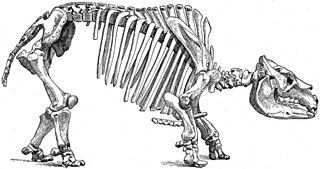 W
WNotoungulata is an extinct order of mammalian ungulates that inhabited South America during the Paleocene to the Holocene, living from approximately 57 Ma to 11,000 years ago. Notoungulates were morphologically diverse, with forms resembling animals as disparate as rabbits and rhinoceroses. Notoungula were the dominant group of ungulates in South America during the Paleogene and early Neogene. Their diversity declined during the Late Neogene, with only the large toxodontids persisting until the end of the Pleistocene. Several groups of Notoungulates separately evolved ever growing teeth like rodents and lagomorphs, a distinction among ungulates only shared with Elasmotherium.
 W
WOmomyidae is a group of early primates that radiated during the Eocene epoch between about 55 to 34 million years ago (mya). Fossil omomyids are found in North America, Europe, Asia, and possibly Africa, making it one of two groups of Eocene primates with a geographic distribution spanning holarctic continents, the other being the adapids. Early representatives of the Omomyidae and Adapidae appear suddenly at the beginning of the Eocene in North America, Europe, and Asia, and are the earliest known crown primates.
 W
WOxyaena is an extinct genus of oxyaenid mammal from the latest Paleocene to early Eocene of North America. The species were superficially cat or wolverine-like, with a flexible body 1 metre (3.3 ft) long, and short limbs. Some species like Oxyaena forcipata were bigger with a body mass estimated to be 20 kg.
 W
WPalaeonictis is an extinct hyena-like predatory mammal belonging to the family Oxyaenidae, existing from the late Paleocene to the early Eocene times.
 W
WPantodonta is an extinct suborder of eutherian mammals. These herbivorous mammals were one of the first groups of large mammals to evolve after the end of the Cretaceous. The last Pantodonts died out at the end of the Eocene.
 W
WPeriptychidae is a family of Paleocene placental mammals, known definitively only from North America. The family is part of a radiation of early herbivorous and omnivorous mammals classified in the extinct order Condylarthra, which may be related to some or all living ungulates. Periptychids are distinguished from other condylarths by their teeth, which have swollen premolars and unusual vertical enamel ridges. The family includes both large and small genera, with the larger forms having robust skeletons. Known skeletons of periptychids suggest generalized terrestrial habits.
 W
WPhenacodontidae is an extinct family of large herbivorous mammals traditionally placed in the “wastebasket taxon” Condylarthra, which may instead represent early-stage perissodactyls. They lived between the Paleocene and Eocene epochs and their fossil remains have been found in North America and Europe.
 W
WPholidotamorpha is a clade of mammals that includes the orders Palaeanodonta and Pholidota. In the past both orders were formerly classified with various other orders of ant-eating mammals, most notably Xenarthra, which includes the true anteaters, sloths, and the armadillos which pangolins superficially resemble. Newer genetic evidence, however, indicates their closest living relatives are the Carnivora with which they form the clade Ferae. Some palaeontologists, placing Ernanodonta in a separate suborder of Cimolesta near Pholidota, have classified the pangolins in the order Cimolesta, together with several extinct groups indicated (†) below, though this idea has fallen out of favor since it was determined that cimolestids were not placental mammals. A 2015 study has supported close affinities between pangolins and the extinct group Creodonta, as well as many former cimolestans.
 W
WPlanocraniidae is an extinct family of basal crocodylians known from the Paleogene of Asia, Europe and North America. The family was coined by Li in 1976, and contains two genera, Boverisuchus and Planocrania. Planocraniids were highly specialized crocodylians that were adapted to living on land. They have extensive body armor, long legs, and blunt claws resembling hooves, and are sometimes informally called "hoofed crocodiles". Most phylogenetic analyses place planocraniids in a basal position within Crocodylia. Some of these analyses find that planocraniids lie just outside Brevirostres, the group of crocodilians that includes alligators, caimans, and crocodiles but not gharials. Planocraniids are inferred to have first appeared in the Late Cretaceous, several tens of millions of years before they actually occur in the fossil record. This is because the earliest members of Brevirostres appear in the Campanian stage of the Late Cretaceous, and Planocraniidae, being an outgroup to Brevirostres, must have branched off before this time.
 W
WPlesiadapidae is a family of plesiadapiform mammals related to primates known from the Paleocene and Eocene of North America, Europe, and Asia. Plesiadapids were abundant in the late Paleocene, and their fossils are often used to establish the ages of fossil faunas.
 W
WPlesiadapiformes is a group of Primates, as sister of the Dermoptera. While none of the groups normally directly assigned to this group survived, the group appears actually not to be literally extinct as the remaining primates appear to be derived Plesiadapiformes, as sister of e.g. the Carpolestidae. The term Plesiadapiformes may still be used for all primates which are not crown primates, but this usage is obviously paraphyletic. When the crown primates are cladistically granted, it becomes an obsolete junior synonym to primates. Purgatorius is believed to be a basal Plesiadapiformes.
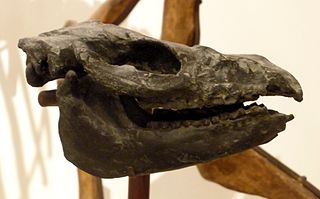 W
WProterotheriidae is an extinct family of fossil ungulates from the Cenozoic era that displays toe reduction. Despite resembling primitive, small horses, they were not related to them, but belonged to the native South American ungulate order Litopterna.
 W
WPyrotheria is an order of extinct meridiungulate mammals. These mastodon-like ungulates include the genera Baguatherium, Carolozittelia, Colombitherium, Gryphodon, Propyrotherium, Proticia, and Pyrotherium.
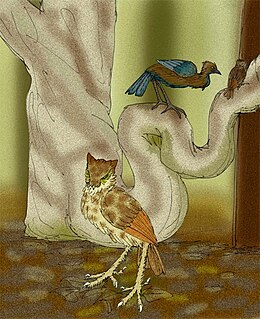 W
WThe Sophiornithidae are an extinct family of chicken-sized predatory birds that lived from the Paleocene to the Eocene periods of the Cenozoic, and were found primarily in Europe, and are thought to be primitive owls.
 W
WSparassodonta is an extinct order of carnivorous metatherian mammals native to South America. They were once considered to be true marsupials, but are now thought to be either a sister taxon to them, or considerably distantly related, part of a separate clade of Gondwanan metatherians. A number of these mammalian predators closely resemble placental predators that evolved separately on other continents, and are cited frequently as examples of convergent evolution. They were first described by Florentino Ameghino, from fossils found in the Santa Cruz beds of Patagonia. Sparassodonts were present throughout South America's long period of "splendid isolation" during the Cenozoic; during this time, they shared the niches for large warm-blooded predators with the flightless terror birds. Previously, it was thought that these mammals died out in the face of competition from "more competitive" placental carnivorans during the Pliocene Great American Interchange, but more recent research has showed that sparassodonts died out long before eutherian carnivores arrived in South America. Sparassodonts have been referred to as borhyaenoids by some authors, but currently the term Borhyaenoidea refers to a restricted subgroup of sparassodonts comprising borhyaenids and their close relatives.
 W
WSveltia is a genus of nutmeg sea snails with an extensive fossil range.
 W
WTillodontia is an extinct suborder of eutherian mammals known from the Early Paleocene to Late Eocene of China, the Late Paleocene to Middle Eocene of North America where they display their maximum species diversity, the Middle Eocene of Pakistan, and the Early Eocene of Europe. Leaving no descendants, they are most closely related to the pantodonts, another extinct group. The tillodonts were medium- to large-sized animals that probably feed on roots and tubers in temperate to subtropical habitats.
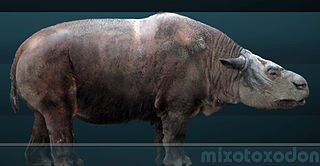 W
WToxodonta or Toxodontia is a suborder of the meridiungulate order Notoungulata. Most of the members of the five included families, including the largest notoungulates, share several dental, auditory and tarsal specializations. The group is named after Toxodon, the first example of the group to be discovered by science.
 W
WTriisodontidae is an extinct, probably paraphyletic, or possibly invalid family of mesonychian placental mammals. Most triisodontid genera lived during the Paleocene in North America, but the genus Andrewsarchus is known from the middle Eocene of Asia. Triisodontids were the first relatively large predatory mammals to appear in North America following the extinction of the dinosaurs. They differ from other mesonychian families in having less highly modified teeth.
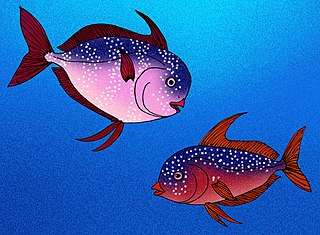 W
WTurkmenidae is an extinct family of lamprids from the Paleogene of Turkmenistan. They were small, disk-shaped fish that bore a strong resemblance to their closest living relatives, the opahs.
 W
WUintatheriidae is a family of extinct ungulate mammals that includes Uintatherium. Uintatheres belong to the order Dinocerata, one of several extinct orders of primitive hoofed mammals that are sometimes united in the Condylarthra.
 W
WVelates is an extinct genus of marine gastropod mollusks belonging to the family Neritidae.
 W
WXenungulata is an order of extinct and primitive South American hoofed mammals that lived from the Late Paleocene to Early Eocene. Fossils of the order are known from deposits in Brazil, Argentina, Peru, and Colombia. The best known member of this enigmatic order is the genus Carodnia, a tapir-like and -sized animal with a gait similar to living African elephants.